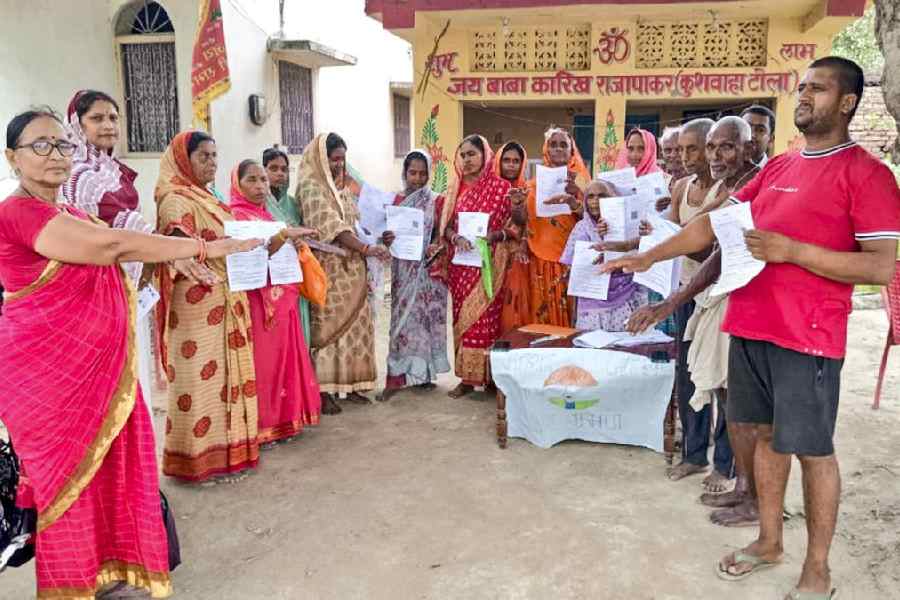The controversy over the Election Commission of India’s Special Intensive Revision of electoral rolls in Bihar, announced on June 24, can only be understood in the context of this government’s commitment to creating a National Register of Citizens. The demand for an NRC originated in Assam. The main motive behind this demand was to exclude illegal migrants from Bangladesh from Indian citizenship.
The Bharatiya Janata Party’s enthusiasm for the NRC was consistent with its general hostility towards Muslims. Bangladesh is a Muslim majority country. The border districts of Assam (and Bengal) have large Muslim populations. Ergo, the exclusion of undocumented aliens would result in the disenfranchisement of Muslims, which would have the double payoff of throwing red meat to the BJP’s base as well as improving its electoral prospects. To be fair to the BJP, this desire to purge Assam of undocumented Muslims was not confined to its leadership; Assamese public intellectuals, student leaders and politicians had been campaigning for this since before the Nellie massacre of 1983.
The campaign to weed out illegal aliens has always been respectable because it appeals to a political common sense. Every self-respecting nation needs to be able to police the boundary between citizens and foreigners. When the suspected foreigners in question are often Muslims, the campaign for the NRC becomes a natural campaigning issue for the BJP.
However, the final draft of the NRC in Assam, submitted in August 2019, was criticised by the BJP because a large part of the nearly two million residents excluded from it were Bengali Hindus and indigenous tribal communities. As a result, the list wasn’t formally notified and the BJP called for its revision.
Meanwhile, to remedy the problem of non-Muslim exclusion, the National Democratic Alliance government came up with the Citizenship (Amendment) Act. By carefully choosing only Muslim majority neighbouring countries, the Act extended an accelerated path to citizenship to non-Muslim, illegal immigrants under the guise of humanitarian asylum for minorities. By keeping neighbouring countries like Sri Lanka and Myanmar out of the purview of the Act (without explanation), persecuted Muslim minorities were excluded by definition.
The CAA’s design was intended to prepare the ground for a revised, all-India NRC. Undocumented non-Muslims could be given the benefit of the doubt and thus, by default, the officials conducting this revision could focus on the one undocumented group that wasn’t protected by the CAA, namely Muslims. The CAA gives official sanction to a form of communal profiling. A revised NRC, filtered through the discriminatory provisions of the CAA, would drastically reduce the Hindus caught in its dragnet, while achieving its main object, the destabilisation of Muslim citizenship.
What does this have to do with the Bihar election? It’s simple: the SIR is the NRC by other means. The SIR shifts the onus of proving citizenship on to voters in a poor state with low levels of literacy and wretched documentation. It grants the EC’s electoral registration officers the discretion to include undocumented voters on the basis of informal evidence gathered through local inquiries. This effectively makes the Election Commission a mai-baap organisation with enormous arbitrary power.
The SIR is actually designed to create arbitrary discretion because the Election Commission has deliberately excluded from the list of acceptable documents the three most common forms of identification: Aadhaar cards, voter ID cards and ration cards. Instead, the EC has asked for birth certificates, passports, pension documents, educational credentials, SC/ST certificates and so on. Anyone who is not on Bihar’s 2003 electoral rolls will have to produce these documents even if they have voted in subsequent elections. It’s worth noting that Bihar is a state where illiteracy is rife, where less than three per cent of children born in the first five years of this century have a birth certificate.
This means that out of nearly eight crore voters, nearly three crore have the burden of proving to the EC’s officers that they are bona fide Indians. They have been given just a month to submit documentation that middle-class people in metropolitan cities would be hard put to produce, such as birth certificates of their parents. The logically relevant documents like voter ID cards and the near-universal Aadhaar cards, used to prove identity for virtually every other transaction, have been excluded.
The Supreme Court recommended that the EC permit the use of voter IDs and Aadhaar cards for the SIR but the recommendation wasn’t binding. The EC’s concession to the Supreme Court was to announce that voters who needed to prove their identity could submit the enumeration forms without documentation for the time being. Their eligibility would be verified later by the EC’s electoral registration officers through local fact-finding. This brings us back to the arbitrariness of the process.
Consider the chances of two inadequately documented twenty-one-year-olds, one Hindu and one Muslim, trying to make it on to Bihar’s electoral roll. All other things being equal, the undocumented Hindu will be viewed either as a local without papers or a migrant entitled to citizenship under the provisions of the CAA. The Muslim’s lack of paperwork, on the other hand, makes him potentially, in the eyes of the State, a false citizen, an encroaching alien from a neighbouring country — Bangladesh, Myanmar, Pakistan and so on — who isn’t entitled to the benefit of the doubt. By creating a religious test for citizenship in a special case via the CAA, the BJP has successfully destabilised Muslim citizenship in a more general way.
This is not to suggest that the only victims of this perverse inquisition are Muslims. It’s likely that the poor, the illiterate, voters from subaltern caste communities will be disproportionately excluded should this process play out as announced. But Muslims are especially vulnerable because the EC’s officials, in the exercise of their vast discretion, have been licensed by the CAA to factor religious profiling into their decision-making. Instead of treating the Aadhaar card as the firm foundation of shared citizenship, the EC has chosen to consign great swathes of Bihar’s — and by implication, India’s — population to an electoral limbo. That its officials will sort through this disenfranchised population via opaque local inquiries and in the dark light of the CAA is not reassuring.
Amit Shah promised to implement the NRC across India. The NDA government hasn’t been able to make good on that promise. The EC’s SIR looks remarkably like an improvised shortcut to the NRC, with the EC unwisely making itself the arbiter of citizenship.
The Election Commission was designed as a statutory body to insulate it from political interference. It shouldn’t risk even the appearance of implementing the home
ministry’s agenda. Having just completed a special summary revision of Bihar’s electoral roll earlier this year, the EC’s decision to drastically revise the roll again so close to the election in November does it no favours. Worse still, it stirs controversy about the fairness of Bihar’s imminent elections. Given that fair elections are now India’s sole claim to being a democracy, this is a controversy that the country could have done without.
mukulkesavan@hotmail.com










